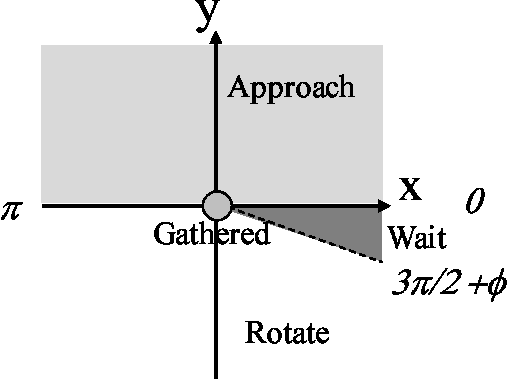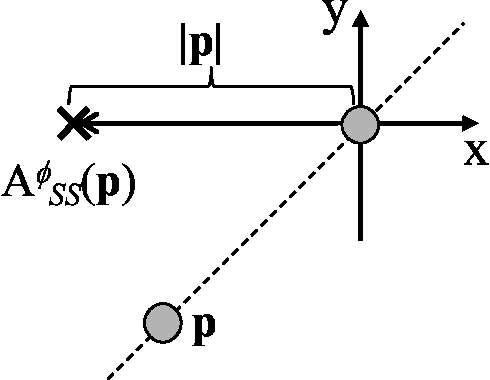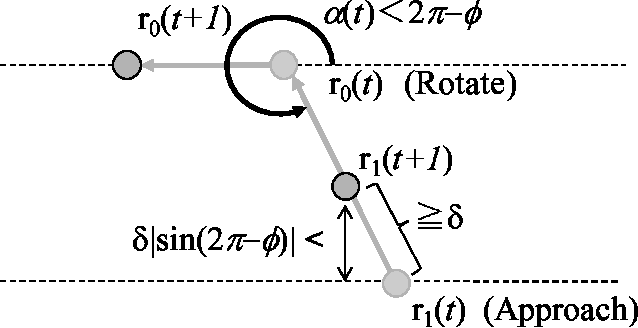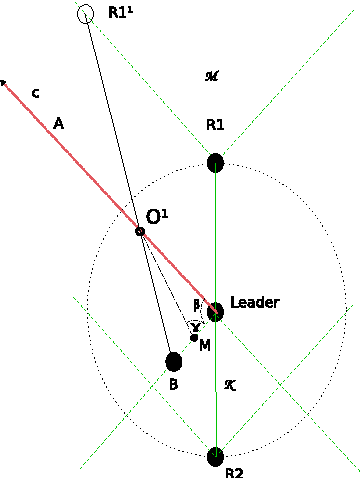Taisuke Izumi
NIT
The Gathering Problem for Two Oblivious Robots with Unreliable Compasses
Nov 07, 2011



Abstract:Anonymous mobile robots are often classified into synchronous, semi-synchronous and asynchronous robots when discussing the pattern formation problem. For semi-synchronous robots, all patterns formable with memory are also formable without memory, with the single exception of forming a point (i.e., the gathering) by two robots. However, the gathering problem for two semi-synchronous robots without memory is trivially solvable when their local coordinate systems are consistent, and the impossibility proof essentially uses the inconsistencies in their coordinate systems. Motivated by this, this paper investigates the magnitude of consistency between the local coordinate systems necessary and sufficient to solve the gathering problem for two oblivious robots under semi-synchronous and asynchronous models. To discuss the magnitude of consistency, we assume that each robot is equipped with an unreliable compass, the bearings of which may deviate from an absolute reference direction, and that the local coordinate system of each robot is determined by its compass. We consider two families of unreliable compasses, namely,static compasses with constant bearings, and dynamic compasses the bearings of which can change arbitrarily. For each of the combinations of robot and compass models, we establish the condition on deviation \phi that allows an algorithm to solve the gathering problem, where the deviation is measured by the largest angle formed between the x-axis of a compass and the reference direction of the global coordinate system: \phi < \pi/2 for semi-synchronous and asynchronous robots with static compasses, \phi < \pi/4 for semi-synchronous robots with dynamic compasses, and \phi < \pi/6 for asynchronous robots with dynamic compasses. Except for asynchronous robots with dynamic compasses, these sufficient conditions are also necessary.
The BG-simulation for Byzantine Mobile Robots
Jun 01, 2011Abstract:This paper investigates the task solvability of mobile robot systems subject to Byzantine faults. We first consider the gathering problem, which requires all robots to meet in finite time at a non-predefined location. It is known that the solvability of Byzantine gathering strongly depends on a number of system attributes, such as synchrony, the number of Byzantine robots, scheduling strategy, obliviousness, orientation of local coordinate systems and so on. However, the complete characterization of the attributes making Byzantine gathering solvable still remains open. In this paper, we show strong impossibility results of Byzantine gathering. Namely, we prove that Byzantine gathering is impossible even if we assume one Byzantine fault, an atomic execution system, the n-bounded centralized scheduler, non-oblivious robots, instantaneous movements and a common orientation of local coordinate systems (where n denote the number of correct robots). Those hypotheses are much weaker than used in previous work, inducing a much stronger impossibility result. At the core of our impossibility result is a reduction from the distributed consensus problem in asynchronous shared-memory systems. In more details, we newly construct a generic reduction scheme based on the distributed BG-simulation. Interestingly, because of its versatility, we can easily extend our impossibility result for general pattern formation problems.
Emergent velocity agreement in robot networks
May 20, 2011



Abstract:In this paper we propose and prove correct a new self-stabilizing velocity agreement (flocking) algorithm for oblivious and asynchronous robot networks. Our algorithm allows a flock of uniform robots to follow a flock head emergent during the computation whatever its direction in plane. Robots are asynchronous, oblivious and do not share a common coordinate system. Our solution includes three modules architectured as follows: creation of a common coordinate system that also allows the emergence of a flock-head, setting up the flock pattern and moving the flock. The novelty of our approach steams in identifying the necessary conditions on the flock pattern placement and the velocity of the flock-head (rotation, translation or speed) that allow the flock to both follow the exact same head and to preserve the flock pattern. Additionally, our system is self-healing and self-stabilizing. In the event of the head leave (the leading robot disappears or is damaged and cannot be recognized by the other robots) the flock agrees on another head and follows the trajectory of the new head. Also, robots are oblivious (they do not recall the result of their previous computations) and we make no assumption on their initial position. The step complexity of our solution is O(n).
 Add to Chrome
Add to Chrome Add to Firefox
Add to Firefox Add to Edge
Add to Edge